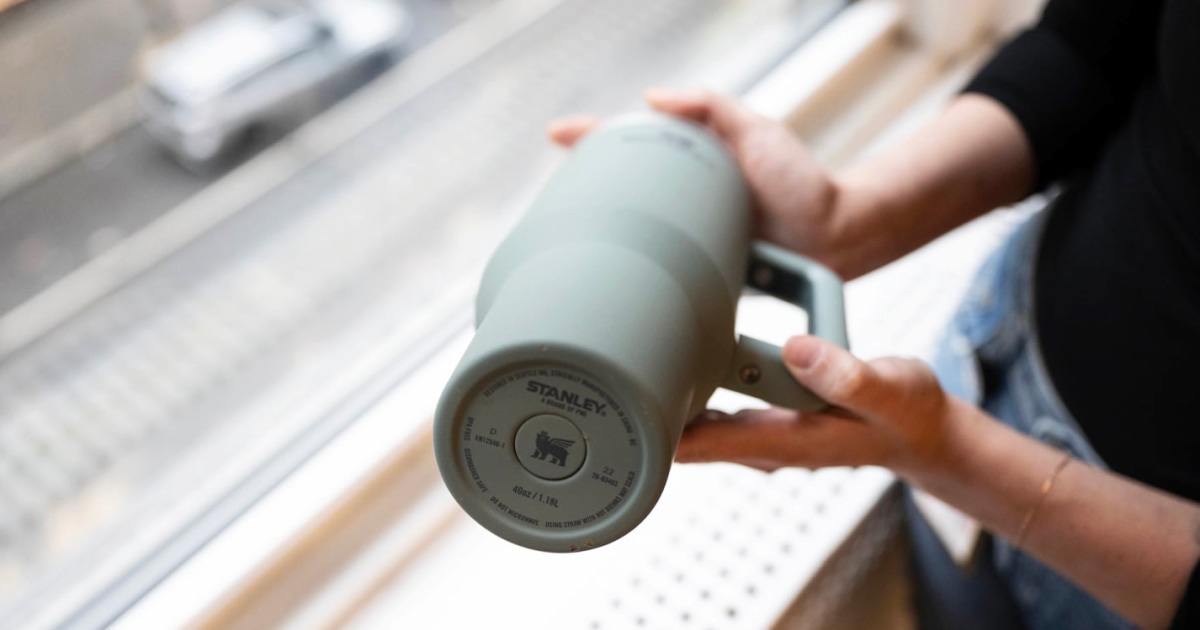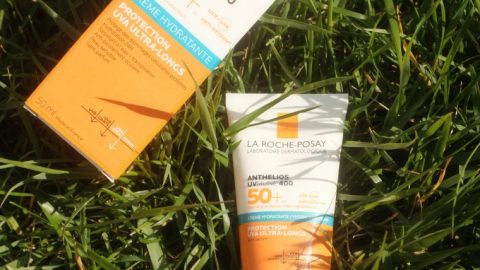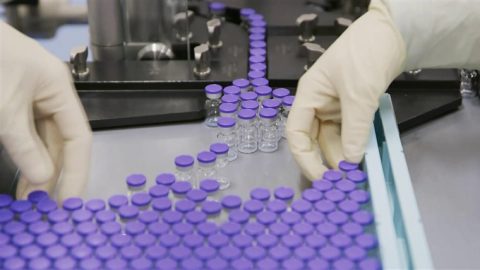
Stanley is responding to claims that its products contain lead, clarifying that, yes, lead is used in the manufacturing process, but the product needs to become damaged to expose the lead, a Stanley spokesperson told TODAY.com in a statement.
On the bottom of each quencher made by the beverage container powerhouse is a circular barrier made of stainless steel, which covers a pellet that contains lead, a spokesperson for Stanley said. The pellet seals the product’s vacuum insulation, and it isn’t accessible unless the stainless steel barrier comes off — which is possible but “rare,” the spokesperson said.
“Our engineering and supply chain teams are making progress on innovative, alternative materials for use in the sealing process,” the spokesperson added. In a separate statement to NBC affiliate WCNC of Charlotte, North Carolina, the company said all of its products follow all U.S. regulatory requirements.
In a recent flurry of social media posts, some Stanley customers said they are using at-home tests to assess whether there’s lead in any of their Stanley products, to mixed results (though what part of the cup is being tested and the quality of lead test being used often aren’t clear).
TODAY.com spoke with multiple experts and government officials to understand why lead exposure is so dangerous and how contamination generally occurs.
Do Stanley cups contain lead?
Yes, Stanley uses lead in its manufacturing process for its cups, but they pose a risk of lead exposure only if the cover on the bottom of the tumbler comes off and exposes the pellet used to seal the cup’s vacuum insulation, a Stanley spokesperson said. If this happens, you can submit a claim through the company’s lifetime warranty.
The liquid inside a Stanley mug doesn’t come in contact with the pellet, so there’s little to no chance of lead exposure from drinking liquid inside the container. The risk is if the circular cover comes off and users touch the exposed lead and then touch their mouths or noses, experts say.
Lead poisoning activist Tamara Rubin, aka Lead Safe Mama, first brought attention to the presence of lead in Stanley tumblers in March 2023. Rubin earns a commission on the products she recommends that are purchased through her website. Some of her recommendations include competitors to Stanley.
She has been passionate about protecting other parents from the dangers of lead poisoning ever since her then-7-month-old son was exposed to lead paint dust during a home renovation and suffered severe permanent brain damage. Rubin now advocates against using lead in any products that enter the home. In February, she sent Consumer Reports a tip based on her own lead testing that later led to a product recall. She has also submitted reports to the U.S. Consumer Product Safety Commission, or CPSC, about similar products that she says led to four additional recalls.
Related: The right and wrong way to clean a Stanley cup, according to experts
Rubin said parents often send her items that they suspect could contain lead, and she uses XRF technology, the same $35,000 spectrometer instrument used by the CPSC, to test for the presence of lead and other heavy metals. She said that she has tested several Stanley tumblers that people have sent her after the protective covers at the bottom have come off and that she has found lead.
“Though some people say [the] protective disc doesn’t come off easily, I’ve heard from many people who say that for them it has,” Rubin said, estimating that the latter group is in the hundreds.
She added that, based on her own experience and what other parents have told her, heavy use, repeated washings and children’s fidgeting with the area can increase the likelihood the covers will come off. She said some people have told her they don’t know how the covers came off and weren’t even aware the cups were damaged at first.
The risks of lead exposure and poisoning
Lead is a naturally occurring metal found abundantly throughout the Earth, per the National Institute of Environmental Health Sciences. Soil usually contains lead concentrations of less than 50 parts per million, but many urban areas contain soil with up to 200 parts per million, according to the Centers for Disease Control and Prevention.
A relatively inexpensive, durable and stable metal that doesn’t rust, lead was once widely used during the early-to-mid-1900s and could be found in toys, gasoline, food, jewelry, cooking utensils, ceramics, electronics, batteries, plumbing pipes, paint and even cosmetics.
Federal and state laws have helped lower the amount of lead people are exposed to, but it is still found in some products today. In fact, the CDC tracks lead-related product recalls, from children’s clothing to food to cosmetics to medicine.
“Most people think of lead poisoning as a thing of the past, but lead is still all around us, often at dangerous enough levels to cause significant harm,” Jenna Forsyth, a research scientist specializing in epidemiology and environmental science at Stanford University School of Medicine, told TODAY.com.
Lead poisoning is most commonly caused by breathing in lead dust or particles, but it can also occur by touching a surface where lead is present, then touching one’s nose or mouth, thereby ingesting trace amounts of the toxic metal, according to the CDC.
“One family I worked with had a young child who got lead poisoning from ingesting oatmeal that he had playfully smashed with the bottom of a water bottle where lead was exposed,” Rubin said. (The bottle wasn’t made by Stanley.)
Once lead enters the bloodstream, it can accumulate and cause severe health consequences, including cardiovascular disease and brain damage. Ronnie Levin, a 40-year veteran scientist with the Environmental Protection Agency who now teaches at Harvard T. H. Chan School of Public Health, told TODAY.com that lead is an “all-systems toxin. … There isn’t a system in your body — from your nervous system to your immune system to your reproductive system — that isn’t harmed by it.”
A study published in The Lancet estimates that in 2019, more than 5 million adults worldwide died from cardiovascular disease related to lead exposure. Children are especially vulnerable, because they absorb lead more easily than adults.
“Even low levels of lead that were once considered safe have been linked to harmful changes in intelligence, behavior and health,” Paul Allwood, the lead poisoning prevention and surveillance branch chief at the CDC’s National Center for Environmental Health, said in an email.
Does this mean I should get rid of my Stanley cup?
As long as that cover at the bottom of your Stanley cup stays in place, Levin said, there is no risk in owning the product. “If that barrier remains intact, you won’t be exposed to any lead and won’t suffer any negative outcomes,” she said.
What’s more, health issues rarely arise from a single instance of lead exposure. “Repeated exposure to lead is what’s most worrisome,” Dr. Vicki Iannotti, a pediatrician at ColumbiaDoctors in Tarrytown, New York, and an assistant professor of pediatrics at Columbia University, told TODAY.com.
It’s that kind of repeated exposure that concerns Rubin the most.
“Children, and especially babies, like to fidget with things that have dimples they can rub,” she said. “If a parent lets their child fidget with an item like a Stanley mug after the bottom cap has come off, there is a very possible and likely transference of microparticulate lead via normal hand-to-mouth behavior in young children.”
Levin echoed similar concerns: “Though lead poisoning is unlikely to happen from a single instance, if a child puts the bottom of one of these cups against their mouth or rubs the surface with their fingers and then puts them in their mouth, contamination can occur.”
Forsyth agreed that risk of exposure from a single instance of touching lead “is pretty low” but said there are scenarios that could increase the risk, such as scraping the exposed led against a hard surface. For example, if a cup with exposed lead is slid across a counter or moved in and out of a cupholder with hard edges, “tiny pieces of lead could flake off,” she said.
And when lead comes in contact with anything acidic, it can become more absorbable, Forsyth said. That could occur if you’re drinking out of a cup with exposed lead and peeling an orange, then touch the exposed lead with fingers that have touched the orange and then touch your nose or mouth. “Ingesting lead is what you need to avoid the most,” Forsyth said.
So keep an eye on the bottom of your Stanley cup to make sure that cover stays where it’s supposed to be. And if the cover does come off and exposes the seal containing lead, customers can submit a claim under the product’s lifetime warranty.
Do other insulated tumblers contain lead?
Stanley isn’t alone in using lead-containing pellets to seal its insulated cups. The Stanley spokesperson said in the statement that the pellet the company uses is “industry standard.” And Rubin said she has tested bottles from other companies that make insulated cups with similar pellets covered in fashion similar to Stanley’s.
It’s important to note that the CPSC monitors products, including insulated tumblers, for violating lead regulations and has recently recalled several children’s products for having accessible pellets that contain levels that exceed the federal lead content ban, CPSC press secretary Patty Davis told TODAY.com. Examples include products sold by PandaEar, Cupkin, Tiblue, Klickpick and Laoion.
Davis encourages consumers to report any lead-related concerns they have for any product on the market to the CPSC at www.saferproducts.gov. “Each report is reviewed and could potentially lead to a recall,” she said.










Recent Comments